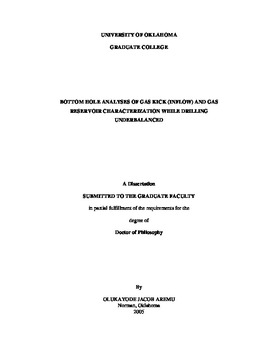| dc.contributor.advisor | Osisanya, Samuel O., | en_US |
| dc.contributor.author | Aremu, Olukayode Jacob. | en_US |
| dc.date.accessioned | 2013-08-16T12:19:46Z | |
| dc.date.available | 2013-08-16T12:19:46Z | |
| dc.date.issued | 2005 | en_US |
| dc.identifier.uri | https://hdl.handle.net/11244/856 | |
| dc.description.abstract | This study presents two new models developed to analyze gas flow between the reservoir and the wellbore while drilling underbalanced. Three drilling operational stages were considered in the analyses. These stages are the continuous drilling and mud circulation; suspension of drilling and mud circulation with the wellbore still opened; and, the shut-in of the wellbore. The first model, called gas bubbly model distinguishes the inflow pattern of gas into a liquid from that of liquid inflow into a liquid, while the second model, a wellbore pressure build-up model, is based on the concepts of increasing annular fluid density during well shut-in. The limitations of these models are the assumption of isothermal wellbore conditions, application of radial unsteady flow equation, and that none of the gas inflow has been produced. | en_US |
| dc.description.abstract | The models couple the viscous, surface tension, inertia, buoyancy, force of fluid ejection from the bit nozzles, and the reservoir forces at the wellbore-sand face contact to analyzing the three drilling operational stages. By incorporating these forces and conducting the analyses at the wellbore-sand face contact, practical characteristics of gas bubbly inflow into a denser fluid system is achieved, thus improving gas formation productivity evaluation while drilling. The improvements are achieved through the reduction of the wellbore effects such as the gas bubble coalescence and breakage, and bubble expansion and compression that are not possible to practically quantify during annular upward flow of gas bubbles. | en_US |
| dc.description.abstract | The chief technical contributions of this study are: (1) Models that take into account the practical characteristics of gas inflow into denser fluid systems are developed. This allows the gas inflow to be treated differently from the liquid inflow. (2) Quantitative analyses of gas inflow at the bottom of the hole are made possible by this study. This approach thus reduces the influences of the wellbore effects on the gas formation productivity evaluation, which is presently approached as the differences in the surface fluid injection rate and the annular outflow rate. | en_US |
| dc.description.abstract | Among many outcomes from the study are: (1) The radial flow equation of gas inflow into the wellbore during underbalanced should be applied deeper than a partially penetrated depth of ≤ 1 ft; (2) Porosity effect on cumulative gas production is not apparent for smaller drilled gas formation intervals, but for longer intervals, gas formations with lower porosity produce more gas volume than ones with higher porosity due to greater pore space compression. This is in agreement with published data. | en_US |
| dc.format.extent | xvi, 244 leaves : | en_US |
| dc.subject | Gas well drilling. | en_US |
| dc.subject | Oil well drilling. | en_US |
| dc.subject | Engineering, Petroleum. | en_US |
| dc.subject | Boring. | en_US |
| dc.title | Bottom hole analyses of gas kick (inflow) and gas reservoir characterization while drilling underbalanced. | en_US |
| dc.type | Thesis | en_US |
| dc.thesis.degree | Ph.D. | en_US |
| dc.thesis.degreeDiscipline | Mewbourne School of Petroleum and Geological Engineering | en_US |
| dc.note | Adviser: Samuel O. Osisanya. | en_US |
| dc.note | Source: Dissertation Abstracts International, Volume: 66-02, Section: B, page: 1149. | en_US |
| ou.identifier | (UMI)AAI3163312 | en_US |
| ou.group | Mewbourne College of Earth and Energy::Mewbourne School of Petroleum and Geological Engineering | |
